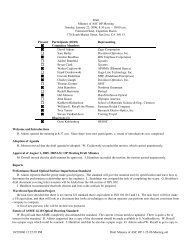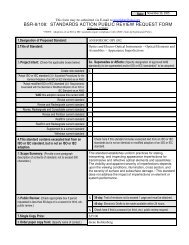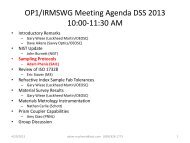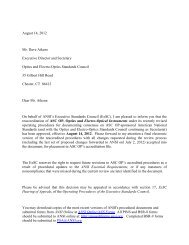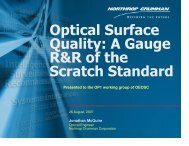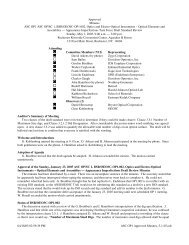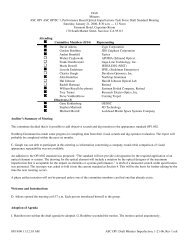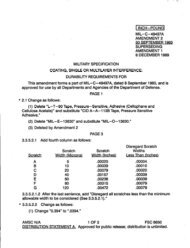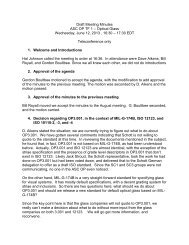INCH-POUND MIL-PRF-13830B 9 January 1997 SUPERSEDING ...
INCH-POUND MIL-PRF-13830B 9 January 1997 SUPERSEDING ...
INCH-POUND MIL-PRF-13830B 9 January 1997 SUPERSEDING ...
You also want an ePaper? Increase the reach of your titles
YUMPU automatically turns print PDFs into web optimized ePapers that Google loves.
<strong>MIL</strong>-<strong>PRF</strong>-<strong>13830B</strong><br />
APPENDIX E<br />
ASTM D4802) window as shown on figure IE. The test fixture shall be placed in an<br />
oven at 71°“ 1°C (160°“ 2°F) for 3 hours, then removed and allowed to cool to a<br />
temperature of approximately 38°C (100°F). The outer surface of the<br />
polymethylmethacrylate window shall be cooled by placing a piece of dry ice having a<br />
flat size of about 0.5 in onto the window of the fixture and allowing it to remain in<br />
contact with the window until condensation is observed on the inner surface of the<br />
window or for a period not greater than 20 minutes. The fixture shall then be<br />
allowed to remain at room temperature for a period of 2 hours. The window of the<br />
fixture shall be removed and its inner surface washed with tap water and wiped with<br />
a soft cloth. The surface shall then be examined with the aid of a 10-power magnifier<br />
in the area where condensation had formed for visual evidence of crazing, pitting, or<br />
etching. Visual examination shall be done by viewing perpendicular to the surface<br />
and then at an angle of 30 to 45° to the surface. Tests shall be performed in<br />
duplicate. Failure of either sample shall be cause for rejection of the lot (see E.3.7).<br />
E.4.5.7 Crazing on stressed acrylic plastic. A piece of acrylic sheet plastic in<br />
accordance with ASTM D4802 shall be set up as a cantilever beam under load, as<br />
shown in figure 2E. After the beam has been loaded for 10 minutes and while still<br />
under load, the compound shall be applied to the top (tension) side of the plastic<br />
specimen two inches from the clamped end and directly above the support and<br />
allowed to remain an additional 10 minutes under load. The acrylic plastic sheet<br />
shall be examined with the aid of a 10 power magnifier for visual evidence of crazing<br />
or other attack while under stress. Visual examination shall be done by viewing<br />
perpendicular to the surface and then at an angle of 30 to 45° to the surface. Visual<br />
evidence of crazing or other attack while under stress constitutes failure of this test.<br />
Failure of the test shall be cause for rejection of the lot (see E.3.8).<br />
E.4.5.8 Low temperature flexibility. Two panels, 1 by 6 by 0.030 in. (2.5 by 15.2<br />
by 0.07 cm) of aluminum surfaced aluminum alloy, ANSI/SAE AMS 4077, shall be<br />
coated on one side with the sealing compound to a thickness of 0.03 in. (0.07 cm).<br />
The panels shall then be immersed for 48 hours at 38°“ 1°C (100° “ 2°F) in a nontoxic<br />
electro-optical grade solvent (ie OptiClear or equivalent). At the completion of<br />
the immersion period, the panels and the flexibility jig (figure 3E), shall be subjected<br />
to a temperature of -40° “ 1°C (-40° “ 2°F) for two hours. While at this temperature,<br />
one end of the test panel shall be placed in the slotted position and the other bent<br />
around the curved portion of the flexibility test jig, at a steady uniform rate such that<br />
3 seconds are required to complete the bend. The panels shall be removed and<br />
examined. Failure of either panel shall be cause for rejection of the lot (see E.3.9).<br />
E.4.5.9 Fluid resistance at elevated temperatures. Two panels, 3 by 5 inches (7.6<br />
by 12.7 cm) of aluminum surfaced alloy conforming to ANSI/SAE AMS 4077 shall be<br />
74<br />
Source: http://www.assistdocs.com -- Downloaded: 2006-05-24T15:32Z<br />
Check the source to verify that this is the current version before use.



